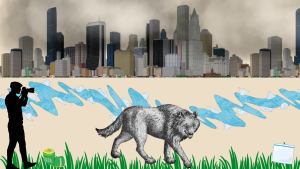On Sept. 24, I attended the showing of Climate Refugees at the Global Peace Film Festival. This documentary depicted places that will be affected by climate change in the near future. The producers of this movie traveled around the world to document how increased temperatures are already having destructive effects in certain countries and how inhabitants are coping with them.
While the movie made compelling cases about the urgency of climate change and how the entire world will be affected, I was discomforted by the number of SUVs, private planes and private boats the crew used to capture evidence supporting an end to global warming. Because of this, I believe the movie is flawed in the sense that it pushes the need for action on climate change, but does not display the people who are preaching these changes living eco-friendly lives. Instead, I believe it makes a strong case for the need to adapt to climate change, and it presents the types of military and industrial changes that will be needed to protect the world from this catastrophe.
A key theme in Climate Refugees is the notion of urgency for action on global warming. To highlight this, the crew first went to Bangladesh, described in the movie as “the ground zero of climate change,” to talk about the 150 million people who are threatened by rising waters due to warmer temperatures. They explained that a one-meter rise in sea level would cost Bangladesh 40 percent of its rice land, 10 percent of which was already lost due to increasing natural disasters.
After touring Bangladesh via a 14-hour private boat trip, the filmmakers took a private plane to the South Pacific and spoke to the people of Tuvalu, whose homeland is projected to be under water in as little as 10 years. One interviewee said she could not be hired in a surrounding country because she is too old for most available jobs. In 10 years she and many others may literally be forced to swim for their lives when the country is submerged. These two examples highlight the political chaos that our future will hold due to huge numbers of people migrating to surrounding countries when their own no longer exist. When it comes to preparing the audience for the political changes that come with global warming, the fi lm effectively does this through these examples, and many interviews with prominent politicians. I was pleased by this aspect of the movie, as it informs viewers of how we will have to adapt to global warming if it continues, which I believe is a strong possibility. However, the filmmakers use the idea of these necessary changes to convey the urgent action that must take place if we want to avoid this catastrophe altogether.
Throughout the film was the idea that the producers of Climate Refugees felt the need to travel around the world by way of private boat, private plane or SUV. While seeing these countries in the movie does make the case more compelling, I felt they could have simply referenced them, or used prior footage from the regions to avoid the astronomical carbon footprint needed to reach them. I have always been a skeptic when it comes to solving global warming, as I feel humans are unwilling to make, and oft en unaware of, the drastic lifestyle changes that need to be made right now to change the Earth’s fate. While Climate Refugees is supposed to compel one to help stop global warming, the best way to make the case is through watching people be the change they wish to see in the world (to paraphrase Mahatma Gandhi), as opposed to simply preaching it. Climate Refugees made great cases for how we will have to adapt to global warming, it only reinforced my skepticism that we can solve this crisis, especially when the producer tells me she is “not sorry” for the film’s carbon footprint.







Be First to Comment